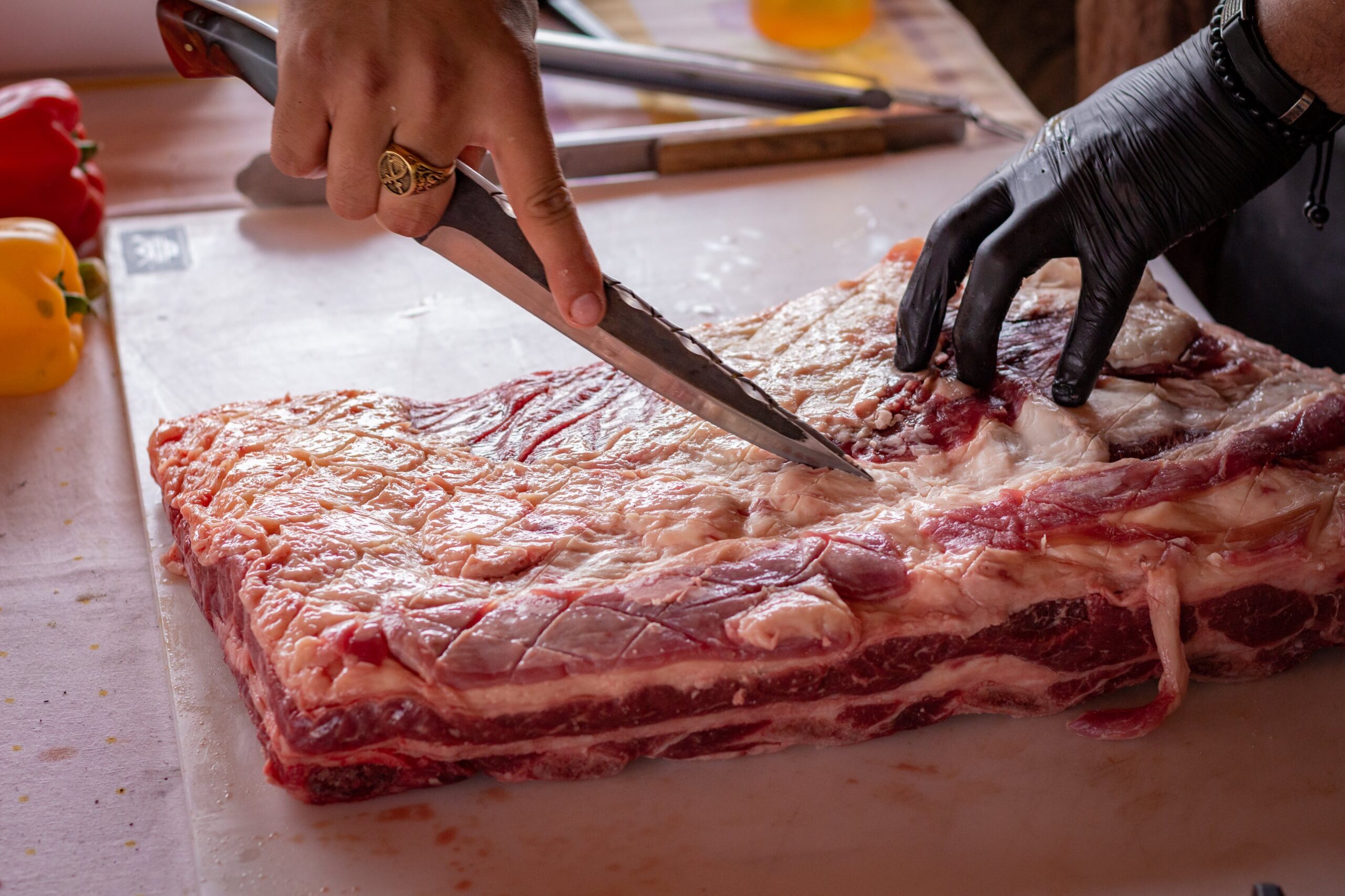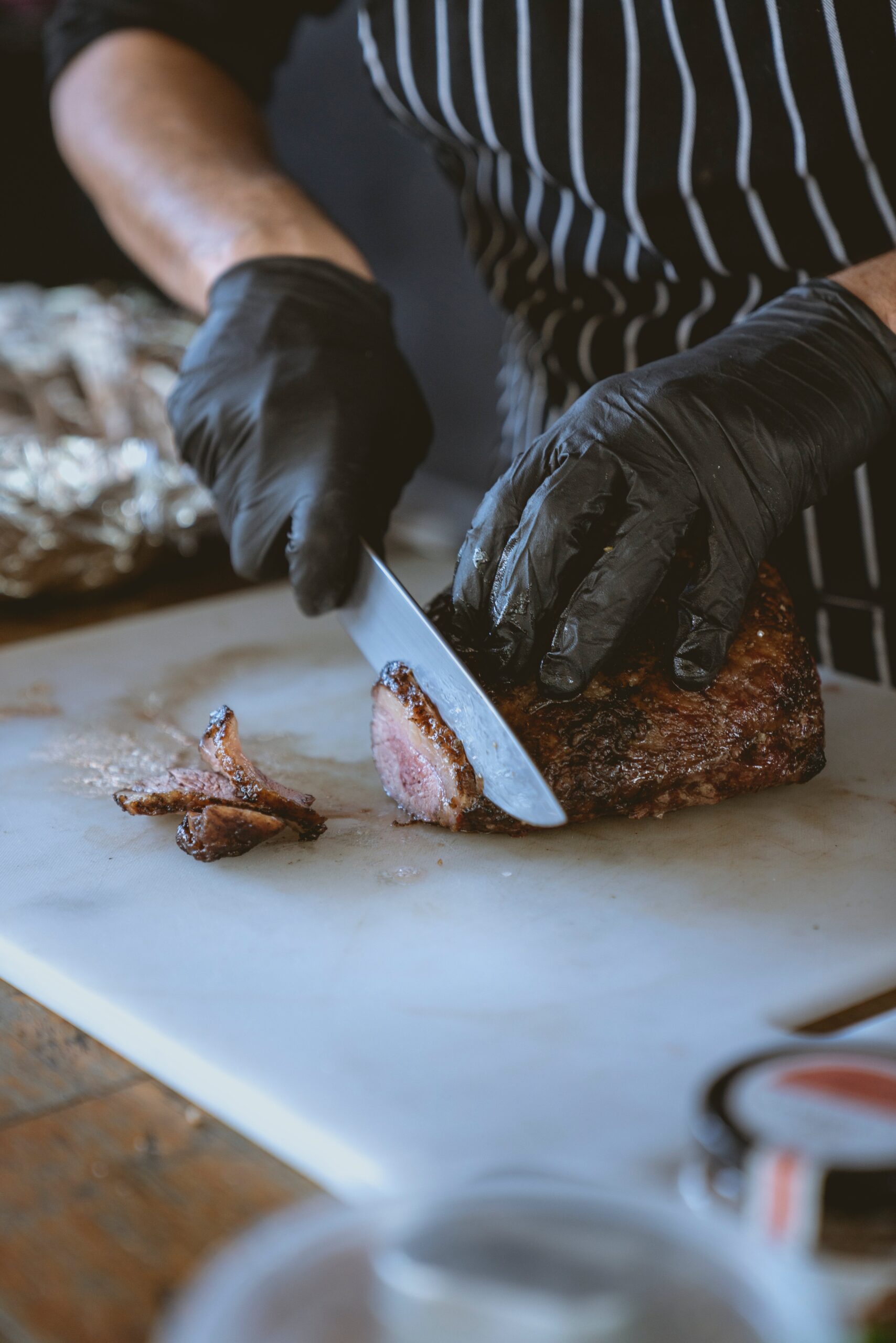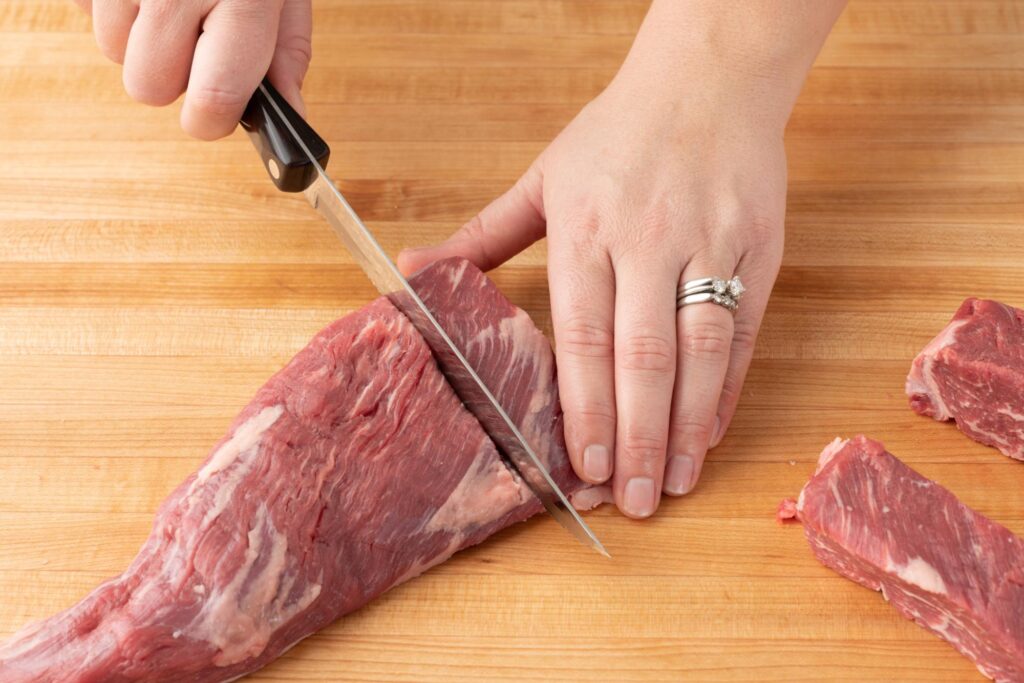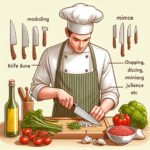The Victorinox Fibrox Pro Chef’s Knife is the best for cutting raw meat. It offers precision, control, and durability.
Chopping, slicing, and carving raw meat demands a knife that combines sharpness, sturdiness, and ease of handling. Professional chefs and home cooks alike often turn to the Victorinox Fibrox Pro Chef’s Knife. Its high-carbon stainless steel blade ensures lasting sharpness and resists corrosion, while its ergonomic Fibrox handle provides a non-slip grip even when wet, making it safe and comfortable to use.
The ideal knife must navigate around bones and sinew, glide through flesh, and ensure clean cuts without unnecessary shredding. The right tool not only enhances safety but also improves cooking results, making the preparation of dishes like steak tartare, chicken cordon bleu, or sushi more efficient and enjoyable.
Introduction To Meat Preparation
Preparing meat requires precision, skill, and the right tools for the job. Ensuring you have the best knife for cutting raw meat not only enhances your culinary experience but also affects the quality of the dish you’re aiming to prepare. A seamless blend of these factors promises succulent and well-cooked meat.
Importance Of The Right Knife
Selecting the ideal knife is crucial for efficiency and texture. The perfect cut starts with sharp blades that glide through meat with minimal effort, preserving its texture and preventing unnecessary shredding. Consider the following points when choosing your go-to meat cutting knife:
- Blade Sharpness: A razor-sharp edge ensures clean cuts without much force.
- Blade Length: Long blades are ideal for large cuts, while shorter knives offer greater control.
- Handle Comfort: A comfortable handle provides a secure grip for safer and more precise cutting.
Types Of Meat Cuts And Their Knife Requirements
Different cuts of meat require specific knives. Below is a breakdown of common cuts and their recommended knives:
| Meat Cut | Knife Type | Why It’s Suitable |
|---|---|---|
| Brisket | Slicing Knife | Long, even strokes are necessary for this tough cut. |
| Steak | Chef’s Knife | Versatile and agile for controlled cuts. |
| Poultry | Boning Knife | Allows finesse around bones and joints. |
Safety And Hygiene Considerations
When handling raw meat, both safety and hygiene are of paramount importance to prevent injury and cross-contamination. Heed these tips for enhanced safety:
- Keep knives sharp; dull knives require more force, increasing the risk of slippage.
- Always use a cutting board to protect countertops and stabilize the meat.
- Clean knives thoroughly after every use to avoid the spread of bacteria.
- Store knives in a safe place, such as a knife block or magnetic strip, away from reach of children.

Anatomy Of A Butcher’s Knife
Understanding the Anatomy of a Butcher’s Knife is essential for anyone serious about cooking or meat processing. The right knife not only tackles the challenge of cutting through different types of raw meat with precision but also ensures comfort and safety during use. Let’s dissect the key components that make up a butcher’s knife, from the materials used to forge its blade to the balance that enables efficient cutting.
Blade Materials And Edge Types
The blade forms the core of a butcher’s knife and its efficacy in slicing raw meat. Most of these blades are crafted from either stainless steel or high-carbon steel, each with its unique benefits. Stainless steel is prized for its resistance to corrosion and ease of maintenance, whereas high-carbon steel holds a sharper edge for longer, providing unparalleled precision in cutting.
When it comes to edge types, there are two prevalent designs:
- Straight edges offer clean cuts and are ideal for slicing meat smoothly.
- Granton edges have hollowed-out grooves that minimize sticking, allowing the blade to glide through the meat.
Handle Ergonomics And Material Choices
A handle’s design heavily influences the user’s grip and the knife’s overall functionality. Butcher knives typically feature ergonomic handles that contour to the user’s hand, reducing fatigue during prolonged use. Materials range from synthetic options like polypropylene which is durable and easy to clean, to classic wooden handles that offer a traditional look and comfortable grip.
Here’s a quick overview of handle materials:
| Material | Advantages | Disadvantages |
|---|---|---|
| Polypropylene | Water-resistant, durable | May feel less premium |
| Wood | Comfortable grip, aesthetic appeal | Requires more maintenance |
| Rubber | Non-slip, shock absorbent | Less resistant to heat |
Knife Balance And Its Impact On Cutting Efficiency
Balance plays a pivotal role in the performance of a butcher’s knife. A well-balanced knife feels like an extension of the arm, allowing for precise and effortless cutting. The point of balance should always be near where the handle meets the blade, ensuring that neither end feels heavier. This balance reduces the strain on the user’s hand, increasing control and reducing the risk of accidents during the cutting process.
Here’s how a balanced knife enhances cutting efficiency:
- Improves control and stability during precise cuts.
- Reduces hand and wrist fatigue.
- Ensures uniform slices and helps maintain the integrity of the meat.
Top Knives For Cutting Raw Meat
Every home cook or professional chef knows that preparing meat requires not only skill but also the right tools. One essential aspect of meat preparation is having a knife that cuts cleanly and efficiently. The market offers a wide range of knives designed for this purpose, each with unique features tailored to different cutting tasks. Let’s slice into the topic and discover the top knives for cutting raw meat that could change the way you prep your dishes.
Chef’s Knife: A Versatile Option
A chef’s knife is the quintessential all-rounder in the kitchen. Typically ranging from 6 to 12 inches, this knife features a broad and sharp blade that can handle a variety of meats. Whether you’re slicing beef, dicing chicken, or carving a lamb roast, the heft and balance of a quality chef’s knife ensure smooth and swift cutting.
Boning Knife: For Precision And Delicate Cuts
When it comes to removing bones from meat or filleting fish, a boning knife is your best bet. Its thin, flexible blade allows for precise cuts, making it perfect for maneuvering around bones and cutting through tendons. The boning knife’s design ensures minimal waste and maximizes the amount of meat one can extract from around the bone.
Cleaver: For Heavy-duty Chopping
For those tougher jobs that require a little more heft, a cleaver comes in handy. It’s a substantial tool with a thick blade, designed to slice through dense meat and even bone with ease. If you’re dealing with larger cuts or preparing cuts like pork ribs, a cleaver’s power is unmatched. Not only does it make quick work of challenging tasks, but it also helps in finely mincing meat for dishes like dumplings.
Carving Knife: Ideal For Large Cuts
When your cooking calls for serving up succulent slices of larger meats like turkey, ham, or roasts, reach for a carving knife. With its long, skinny blade, a carving knife delivers clean and even cuts. It’s designed to create the perfect slice without tearing or shredding, which is essential for maintaining the integrity of your meat’s texture and flavor.
Santoku Knife: The Multi-purpose Alternative
The Santoku knife is a beloved staple in Japanese kitchens and has gained global popularity for good reason. This knife features a unique ‘sheep’s foot’ blade tip that provides a more linear cutting edge. This design lets the cook achieve more precise, straight cuts. While it’s excellent for slicing, dicing, and mincing, the Santoku’s versatility makes it ideal for processing raw meat, offering an effortless chopping experience.

Maintaining Your Meat-cutting Knives
Selecting the best knife for cutting raw meat is only the beginning of your culinary journey. Equally important is maintaining your knives to ensure they perform optimally for longer periods. Whether you’re a seasoned chef or a home cook, understanding how to keep your meat-cutting knives in top condition is a must. From sharpening techniques to proper storage, this post will guide you through preserving the cutting prowess of your kitchen’s unsung heroes.
Sharpening Techniques And Tips
Sharp knives are safe knives. A well-maintained edge not only cuts efficiently but also reduces the risk of the knife slipping off the meat and causing injury. Use the following tips to keep your blades razor-sharp:
- Honing rods realign the knife-edge between each use. Glide the blade at a 20-degree angle for the best results.
- Whetstones or sharpening stones are ideal for occasional thorough sharpening. Soak the stone, then run the blade across it in smooth strokes.
- Consider a professional sharpening service once or twice a year to restore the blade to its original sharpness.
Storage Solutions To Preserve Blade Integrity
Improper storage can dull your knives faster than you’d expect. Implement these solutions to protect your investment:
- Knife blocks offer convenient and safe storage. Ensure slots are wide enough to avoid edge damage.
- Magnetic strips mounted on the wall can save space and keep knives out of reach of children.
- Blade guards or sheaths are perfect for those who prefer drawer storage. They prevent edge-on-edge contact that can dull blades.
Cleaning And Disinfection Best Practices
Raw meat can leave pathogens on your knives which may cause cross-contamination. Follow these best practices to ensure your knives are not only clean but sanitized:
| Cleaning Steps | Disinfection Stage |
|---|---|
| Use hot, soapy water to wash the knife immediately after use. | Apply a disinfectant, such as a mild bleach solution, or use a dishwasher with a sanitizing cycle. |
| Dry the knife completely with a clean towel to prevent rust. | Store the knife in a dry space to avoid moisture buildup. |
By incorporating these sharpening, storage, and cleaning methods into your routine, your meat-cutting knives will remain dependable, sharp, and ready to tackle any culinary challenge.
Buying Guide For Meat-cutting Knives
Identifying the best knife for cutting raw meat is crucial for both culinary enthusiasts and professional chefs. A well-chosen knife ensures clean cuts, reduced effort during prep, and longevity of your tools. This buying guide will help navigate through the various options available, focusing on essential factors, price range, brand comparisons, and shopping avenues.

Factors To Consider Before Purchase
Selecting the right meat-cutting knife involves considering several key elements that can affect performance and user experience:
- Blade Material: Look for high-carbon stainless steel for a balance of sharpness and durability.
- Blade Length: A longer blade is ideal for clean, single-stroke cuts on larger pieces of meat.
- Handle Comfort: Ergonomic designs reduce hand fatigue, especially during extensive use.
- Edge Type: Whether serrated or straight affects the preparation style and maintenance.
- Knife Balance: A well-balanced knife offers better control and precision.
- Maintenance: Consider ease of sharpening and whether the knife is dishwasher-safe.
Price Range And Brand Comparisons
Meat-cutting knives come in various price tiers, each offering a different set of features and brand reputations. Here’s a quick breakdown:
| Price Range | Typical Features | Notable Brands |
|---|---|---|
| Entry-Level | Basic functionality, less durable materials | Victorinox, Mercer Culinary |
| Mid-Range | Improved materials, added ergonomic features | Wusthof, Global |
| Premium | High-end materials, superior craftmanship, warranty | Shun, Miyabi |
While premium brands come with a heftier price tag, their quality and longevity often justify the investment for serious cooks.
Where To Buy: Online Vs In-store
Your choice between shopping online or in-store for a meat-cutting knife can impact not just price, but also satisfaction. Consider the following:
- Online stores often provide a vast selection and competitive pricing.
- Physical stores allow you to feel the knife in hand, which is essential for checking comfort and balance.
- Online customer reviews are a valuable resource for assessing long-term user satisfaction.
- In-store experts can offer personalized recommendations and tips.
Whether opting for the convenience of online shopping or the hands-on experience of an in-store purchase, ensure a reliable return policy is in place.
Final Recommendations For Home Cooks And Professionals
For home cooks, a durable Chef’s knife can take you a long way, addressing most raw meat-cutting needs. Professionals, on the other hand, might invest in a broader range that includes specialized knives such as a flexible boning knife and a heavy-duty cleaver. Key attributes – blade sharpness, handle comfort, and materials – should guide the final selection, ensuring a blend of functionality and longevity.
Future Trends In Cutlery For Meat Handling
The cutlery industry continues to innovate, with future trends pointing toward sustainable materials and ergonomic designs. Advances may introduce novel alloys and ceramics that extend the life of the blade while minimizing maintenance. Moreover, the rise of smart technology in kitchens could see knives equipped with sensors to guide cuts or even smart handles that adapt to the user’s grip. Such advancements promise to elevate the culinary experience and further simplify the process of preparing raw meat.
Choosing the right knife can transform your meat preparation from a chore into a culinary adventure. Remember to prioritize quality, comfort, and the specific needs of your cooking style. The future of cutlery is bright and innovative, and staying informed will ensure your kitchen is always cutting-edge!
Conclusion
Selecting the right knife for cutting raw meat is crucial. It enhances your culinary skills and ensures safety. Remember, an ideal blade combines sharpness, durability, and comfort. Embrace your cooking journey with the perfect knife, and you’ll notice a delightful difference.
Happy cooking and effortless slicing await!
Frequently Asked Questions For Best Knife For Cutting Raw Meat
What Is The Best Type Of Knife For Raw Meat?
A chef’s knife is ideal for cutting raw meat. Its sharp, broad blade allows precise cuts and can handle various meat types. It’s versatile and a kitchen essential.
How To Choose A Raw Meat Cutting Knife?
Look for a knife with a sturdy handle, a balanced design, and a sharp, durable blade. High-carbon stainless steel is a popular and reliable material for such knives.
Are There Specific Knives For Different Meats?
Yes, there are specific knives for different meats. For example, a boning knife is perfect for separating meat from bone, while a slicing knife is great for cutting thin slices of meat.
What Size Knife Is Best For Cutting Meat?
A blade between 8 to 10 inches is best for cutting meat. It gives good control and can handle both small and large cuts. Choose based on the meat portions you typically handle.







